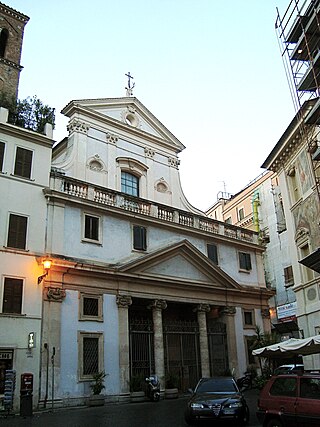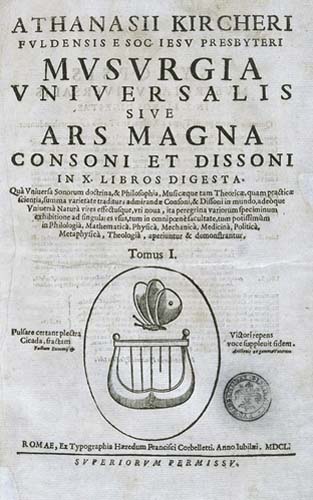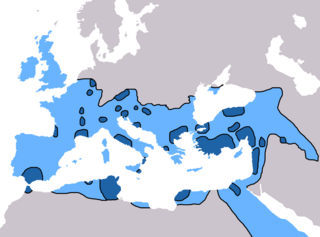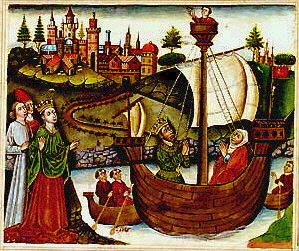
Athanasius Kircher was a German Jesuit scholar and polymath who published around 40 major works of comparative religion, geology, and medicine. Kircher has been compared to fellow Jesuit Roger Joseph Boscovich and to Leonardo da Vinci for his vast range of interests, and has been honoured with the title "Master of a Hundred Arts". He taught for more than 40 years at the Roman College, where he set up a wunderkammer. A resurgence of interest in Kircher has occurred within the scholarly community in recent decades.

Saint Eustace is revered as a Christian martyr. According to legend, he was martyred in AD 118, at the command of emperor Hadrian. Eustace was a pagan Roman general, who converted to Christianity after he had a vision of the cross while hunting. He lost all his wealth, was separated from his wife and sons, and went into exile in Egypt. Called back to lead the Roman army by emperor Trajan, Eustace was happily reunited with his family and restored to high social standing, but after the death of Trajan, he and his family were martyred under Hadrian for refusing to sacrifice to pagan Roman gods.

Hubertus or Hubert was a Christian saint who became the first bishop of Liège in 708 A.D. He is the patron saint of hunters, mathematicians, opticians and metalworkers. Known as the "Apostle of the Ardennes", he was called upon, until the early 20th century, to cure rabies through the use of the traditional Saint Hubert's Key.

Deer have significant roles in the mythology of various peoples located all over the world, such as object of worship, the incarnation of deities, the object of heroic quests and deeds, or as magical disguise or enchantment/curse for princesses and princes in many folk and fairy tales.

Macarius I ; was Bishop of Jerusalem from 312 to shortly before 335, according to Sozomen. He is recognized as a saint within the Orthodox and Catholic churches.
Salamanes Hermias Sozomenos, also known as Sozomen, was a Roman lawyer and historian of the Christian Church.

Amphibalus is a venerated early Christian priest said to have converted Saint Alban to Christianity. He occupied a place in British hagiography almost as revered as Alban himself. According to many hagiographical accounts, including those of Gildas, Bede, Geoffrey of Monmouth, and Matthew of Paris, Amphibalus was a Roman Christian fleeing religious persecution under Emperor Diocletian. Amphibalus was offered shelter by Alban in the Roman city of Verulamium, in modern-day England. Alban was so impressed with the priest's faith and teaching that he began to emulate him in worship, and eventually became a Christian himself. When Roman soldiers came to seize Amphibalus, Alban put on Amphibalus' robes and was punished in his place. According to Matthew Paris, after Alban's martyrdom, the Romans eventually caught and martyred Amphibalus as well.
Constantine was a 6th-century king of Dumnonia in sub-Roman Britain, who was remembered in later British tradition as a legendary King of Britain. The only contemporary information about him comes from Gildas, who castigated him for various sins, including the murder of two "royal youths" inside a church. The historical Constantine is also known from the genealogies of the Dumnonian kings, and possibly inspired the tradition of Saint Constantine, a king-turned-monk venerated in Southwest Britain and elsewhere.

During the reign of the Roman Emperor Constantine the Great, Christianity began to transition to the dominant religion of the Roman Empire. Historians remain uncertain about Constantine's reasons for favoring Christianity, and theologians and historians have often argued about which form of early Christianity he subscribed to. There is no consensus among scholars as to whether he adopted his mother Helena's Christianity in his youth, or, as claimed by Eusebius of Caesarea, encouraged her to convert to the faith he had adopted.

The Crucifixion of Saint Peter is a work by Michelangelo Merisi da Caravaggio, painted in 1601 for the Cerasi Chapel of Santa Maria del Popolo in Rome. Across the chapel is a second Caravaggio work depicting the Conversion of Saint Paul on the Road to Damascus (1601). On the altar between the two is the Assumption of the Virgin Mary by Annibale Carracci.

The Basilica of Saint Sylvester the First, also known as, is a Roman Catholic minor basilica and titular church in Rome dedicated to Pope Sylvester I. It is located on the Piazza San Silvestro, at the corner of Via del Gambero and the Via della Mercede, and stands adjacent to the central Post Office.

Sant'Eustachio is a Roman Catholic titular church and minor basilica in Rome, named for the martyr Saint Eustace. It is located on Via di Sant'Eustachio in the rione Sant'Eustachio, a block west of the Pantheon and via della Rotonda, and a block east of Sant'Ivo alla Sapienza and the Via della Dogana Vecchia.

Musurgia Universalis, sive Ars Magna Consoni et Dissoni is a 1650 work by the Jesuit scholar Athanasius Kircher. It was printed in Rome by Ludovico Grignani and dedicated to Archduke Leopold Wilhelm of Austria. It was a compendium of ancient and contemporary thinking about music, its production and its effects. It explored, in particular, the relationship between the mathematical properties of music with health and rhetoric. The work complements two of Kircher's other books: Magnes sive de Arte Magnetica had set out the secret underlying coherence of the universe and Ars Magna Lucis et Umbrae had explored the ways of knowledge and enlightenment. What Musurgia Universalis contained, through its exploration of dissonance within harmony, was an explanation of the presence of evil in the world.
Saint Constantine is the name of one or many British or Pictish saints.

Christianity in the 4th century was dominated in its early stage by Constantine the Great and the First Council of Nicaea of 325, which was the beginning of the period of the First seven Ecumenical Councils (325–787), and in its late stage by the Edict of Thessalonica of 380, which made Nicene Christianity the state church of the Roman Empire.

The Book of the Knight Zifar is the earliest fictional adventure tale in prose in the Spanish language. It was written around 1300, probably by a cleric of Toledo, Ferrand Martínez, who is mentioned in the prologue. The book has much affinity with contemporary works of chivalric romance.
Filippo Martinucci was an Italian architect. He was the son of Vincenzo Martinucci. His son, also Vincenzo, was also an architect who collaborated with his father on several projects.

Phonurgia Nova is a 1673 work by the Jesuit scholar Athanasius Kircher. It is notable for being the first book ever dedicated entirely to the science of acoustics, and for containing the earliest description of an aeolian harp. It was dedicated to the Holy Roman Emperor Leopold I and printed in Kempten by Rudoph Dreherr.

Latium is a 1669 work by the Jesuit scholar Athanasius Kircher. It was dedicated to Pope Clement X and a 1671 edition was published in Amsterdam by Johannes van Waesbergen. The work was the first to discuss the topography, archeology and history of the Lazio region. It was based partly on Kircher's extensive walks in the countryside around Rome, although it included sites that he had probably not visited in person. The work included many illustrations of the contemporary countryside, as well as reconstructions of ancient buildings. It also included an account of his discovery of the ruined sanctuary at Mentorella, which he had already recounted in his 1665 work Historia Eustachio Mariana.

This article lists historical events that occurred between 301–400 in modern-day Lebanon or regarding its people.





















